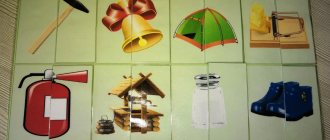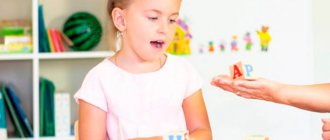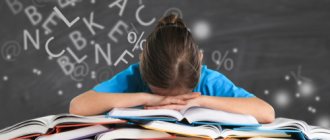I. Cabinet equipment:
- Wall mirror (at least 1.5 - 0.5 m).
- Children's table mirrors (9 x 12) according to the number of children.
- Children's tables and chairs for classes.
- Table for speech therapist.
- Two chairs for adults.
- Additional lighting at the mirror (table lamp).
- A table clock.
- Cabinets and shelves for methodological literature.
- Wall mounted school board.
- Typesetting canvas.
- Flannelograph.
- Clean towel.
- Card file for available benefits.
- Boxes or folders of the same size and color for storing manuals.
A speech therapist is a correctional teacher who eliminates speech disorders in children and adults. Most of the speech therapist's clients are children aged from 3 months to school age.
For children aged 3 months to 1 year, a specialist carries out early diagnosis and prevention of speech disorders. With children aged 2 to 4 years, he diagnoses and prevents speech and mental development delays. In children under 7 years of age, diagnoses and corrects sound pronunciation, expands and enriches vocabulary, develops coherent speech, etc. With older children and adults, work is also usually aimed at eliminating defects in sound pronunciation.
The sphere of professional interests of a speech therapist includes disorders of sound pronunciation, speech (written and oral, its tempo and rhythm), underdevelopment or loss of speech.
A speech therapist is a mandatory staff position in preschool and school institutions.
Its work is regulated by Order of the Ministry of Health of the Russian Federation No. 92n dated March 7, 2021 “On approval of the Regulations on the organization of primary health care for children.”
Criteria for organizing an office
The office is decorated and equipped, taking into account the specifics of the speech therapist’s work. Here are the criteria by which a speech therapist’s office is planned and organized:
- Safety and health of children - it is necessary to comply with the requirements for lighting, ventilation, heating, cleanliness, furniture, schedule of activities with children of different ages, etc.;
- Suitable for the age of children - classes must be built in a playful way, observing safety precautions, avoiding overload of the child’s body and psyche;
- Correction - it is necessary to create optimal conditions for correcting violations.
This approach to organizing the work of a speech therapy room provides all the conditions for the safety, health of children and effective correction.
Premises requirements
Typically, a room on the first floor is allocated for a speech therapist’s office. It should be suitable for conducting classes with children in group and individual forms. A speech therapist works with one child or with a group of children up to 6 people. The room should be comfortable for the specialist and children, regardless of the size of the group and the nature of the activities.
The requirements for the office are:
- Repair and finishing. Light neutral colors are chosen for floors, walls and furniture so that they do not distract or irritate;
- Ventilation system. The room should be well ventilated. For this purpose, natural sources are used - windows with vents and transoms that function all year round;
- Temperature conditions. The temperature in the speech therapist's office should be 18–24 degrees, depending on the season and climatic conditions. To control the air temperature, use a household thermometer. It is mounted at a height of about 1 meter on the internal wall;
- Heating system. Portable and infrared heating devices are prohibited;
- Lighting system. Design side left-side natural lighting. Do not allow light to fall from the front or back of children. Blinds or curtains are installed on the windows to protect from the sun. If natural lighting is not enough, artificial lighting is used. A lamp is installed on each table, rigidly attached to the table and with a flexible bracket. The office has both general and individual lighting.
Wall lamps are also installed in the room near the mirror. In order not to reduce the level of natural light, plants with wide leaves and taller than 15 cm are not placed on window sills.
Furniture equipment
The following furniture is needed in a speech therapist's office: a speech therapist's workplace (table, chair), chairs for visitors (parents), cabinets and shelving (for teaching materials, toys, literature, documents, etc.), a clothes hanger.
The office has children's tables and chairs (for 2-4 children) and a common children's round table.
Necessary equipment : wall mirror (0.5–1.5 m), table mirrors 9x12 cm (one for each child), lamps (on tables, near the mirror), table clock, blackboard, typesetting cloth, flannelgraph, boxes for storing manuals.
To work individually with children, you need tools and materials: towel, spatulas, cotton wool, cotton pads, alcohol, speech therapy probes.
Furniture placement
Furniture is arranged in such a way as to ensure the comfort and safety of children. Here are the basic rules:
- Children are seated taking into account their health, vision and hearing;
- Tables are installed next to a light-bearing wall;
- Work tables are organized taking into account the characteristics of children: for right-handed children, the light should fall from the left, for left-handed children - from the right;
- If there is a wall board in the room, the distance from the first table to it is 2.5–3 m;
- The distance of the tables from the light-carrying wall is 1 m;
- If the tables are in several rows, then the distance between them is 0.5 m.
Furniture must be ergonomic, appropriate for the age and height of children, made from safe and durable, moisture-resistant and heat-conducting materials, resistant to detergents and disinfectants. The surface of the tables should have a matte finish, the color of the furniture should be light.
The chalk board must be securely attached to the wall and made of a material that can be easily cleaned with a damp sponge. The color of the board is brown or dark green, matte with anti-reflective coating.
Office zoning
The speech therapist's office is zoned. Each zone is adapted to solve specific problems and has the necessary equipment.
- Correction zone. It is necessary to install a mirror, a work table for children, speech therapy probes, cotton pads, alcohol, a file cabinet for homework, and teaching material (cards, pictures).
- Fine motor development area. Here there are various construction sets, pyramids, nesting dolls, toys, mosaics, lacing, stencils, card files.
- Zone of development of the lexico-grammatical aspect of speech. They are equipped with card indexes of stories and riddles, pictures with plots, etc., word games, and tasks to consolidate the material covered.
- Zone of technical training aids. There is a tape recorder, a voice recorder, an audio library, there may be a laptop and educational discs.
- Speech breathing development zone. Children's musical instruments, straws, tennis balls, a file of breathing exercises, etc. are needed.
- Zone of development of phonemic hearing and sound analysis and synthesis. They are equipped with cards (for example, “Living Sounds” by Alexandrov), “sound pencil cases,” and thematic pictures.
- Documentation area. Separately, they will equip a place for storing speech therapy documentation: speech cards for each child, a log of children’s movements, annual and long-term plans, notebooks for recording and interaction of the speech therapist with educators and teachers, reporting documentation, etc.
- Information zone. In a children's speech therapy group, it is necessary to set up a corner for parents. Here they can get acquainted with the specialist’s work schedule, consultations, recommendations, reminders, etc.
III. Documentation:
- Long-term plan for working with children for the year.
- Calendar plan for frontal, subgroup and individual classes.
- A speech card for each child with the necessary documentation: a) a referral from the speech therapist of the children's clinic to the medical-pedagogical commission; b) an extract from the medical history issued by the pediatrician of the clinic; c) certificates from an ENT specialist, an ophthalmologist, a neurologist, or a psychiatrist; d) characteristics for the child compiled by the teacher of the individual from whom the child comes. Make an entry in the speech card about the child’s progress at least once every 3 months.
- Notebooks for individual work with children.
- Schedule of speech therapy classes with children (timing of working hours for all days of the week).
- Long-term plan for preparing the classroom for the new academic year.
- Self-education plan for the current year.
Equipment for a speech therapy room in a preschool educational institution
Larisa Boglacheva
Equipment for a speech therapy room in a preschool educational institution
Equipment for a speech therapy room in a preschool educational institution
Prepared by: speech therapist MBDOU No. 11 Donetsk
Boglacheva Larisa Leonidovna
Hello, dear colleagues, I recently joined your ranks.
The first difficulty I encountered was preparing and organizing the speech therapy room for its intended purpose.
After reading a large amount of specialized literature, articles, advice from other specialists who share their experience, I made my conclusions and got to work.
The main purpose of a speech therapy room in a preschool educational institution, as we know , is the correction of speech disorders in children.
Firstly, the speech therapy room must be equipped with :
• speech therapy mirror (50*100 cm)
;
• individual mirror for working with children;
• speech therapy probes and spatulas , medical alcohol, cotton wool
sterile, clean towel;
• workplace for a speech therapist teacher to work with documentation and
conducting individual consultations with parents;
• tables and children's chairs (5-6 pcs)
for children who can
adjust depending on the child’s growth;
cabinets, racks for storing educational games, aids for the development of fine motor skills, breathing, mental functions, for storing methodological and visual didactic literature;
• wall clock;
• magnetic board.
Secondly, any speech therapy room must be visually divided into main zones:
1.articulation zone: large wall mirror,
individual mirror, photo albums, posters with articulation gymnastics, tools for sound production;
2.breathing zone: contains materials, games, exercises for
development of speech breathing;
3. zone of phonal perception (intonation)
: toys,
musical instruments, pictures with emotions;
4. zone for the development of general motor skills: aids, games, toys,
natural material, finger games to develop fine motor skills of the hands;
5.methodological zone: plans, notes, library
methodological literature;
6.zones of development of grammar and vocabulary: visual
educational aids and toys; subject, plot and
a series of visual pictures for the development of coherent speech; card indexes (tongue twisters, tongue twisters, nursery rhymes, riddles, finger games, word games and exercises); heroes of puppet and table theater; wall alphabet, chips, magnetic cash register of letters and syllables ;
And in another zone, the 7th, you can add a motivational zone: it includes items for encouragement - symbols (medals, stickers or something else)
for good work and success of the child.
The speech therapist's office should be clean , cozy, and comfortable. The environment you create allows you to develop the child’s mental functions (memory, thinking, perception, attention, forming ideas about the world around him.
A speech therapy room in a kindergarten should not be office or academic.
All material (games, toys, manuals) should be available for use by children as they progress through lexical topics and constantly updated. The child should have the desire and desire to go to the speech therapist’s office , because it’s interesting, unusual and you won’t be bored!
I wish you good luck in creating your own speech therapy office !
What equipment is used in the speech therapy room of a preschool educational institution?
Teachers widely use teaching materials, selected board games, and interactive equipment. It is mandatory to have mirrors and instruments (probes, spatulas) in the office.
Speech therapists note an increase in the effectiveness of lessons using progressive technical means. The advantage of innovative developments remains a clear interface and the availability of programs adapted to the needs expressed by domestic teachers. Employees of the AV Complex company offer their own products, the creation of which took into account the nuances of speech correction and development. In the catalog:
- Children's multimedia and speech therapy complexes. Stylish, attractive models will appeal to kids. They are made from environmentally friendly materials. Thanks to the PROTECT KIDS software package, a safe computer environment for children is organized.
- Furniture tables for a speech therapist's office, designed for children from 3 to 7 years old. Height-adjustable height models for children and schoolchildren up to 14 years old.
Built-in interactive screens support the Multi Touch system for up to 10 touches. The software includes hundreds of training programs and corrective exercises. Using the resources provided, it is easy to interest children and achieve results.
Tasks and games cover all topics: sound pronunciation, phonetics, phonemics, vocabulary. While playing, preschoolers learn to apply skills in practice, improve fine motor skills, and develop thinking processes. Integration with other equipment is possible; there are cables, a surge protector, and connectors. Control is provided using a wireless keyboard and mouse. An appropriate video card and acoustics have been selected.
Furniture modules are equipped with drawers and cabinets, mirrors, and lighting. The decorative body is finished with PVC edge. Company employees guarantee information/technical support to customers. You can place an order by phone, which is listed in the “Contacts” section, or through the form on the website.
“Office of a teacher-speech therapist in kindergarten: requirements of the Federal State Educational Standard for Education” article on speech therapy on the topic
Orlova V.A., teacher - speech therapist
GBDOU kindergarten No. 53 compensatory type
Kalininsky district, St. Petersburg
Article on the topic: “Office of a teacher-speech therapist in a kindergarten: requirements of the Federal State Educational Standard for Education”
The federal state standard of preschool education sets certain requirements for the developing subject-spatial environment of the teacher-speech therapist's office. The relevance of this problem is due to the need to improve the correctional and developmental environment in preschool institutions in accordance with the new requirements of the Federal State Educational Standard for preschool education. The correctional and developmental environment, in contrast to the subject-developmental environment, solves the main problem of correctional assistance and the organization of conditions for correction, overcoming, and adaptation of children with developmental disabilities. The results of speech therapy work depend on many factors, but an important point in the successful correction of speech disorders is the creation of an optimal correctional and developmental environment in the speech therapy room of a preschool institution.
Speech development is the most important condition for the full development of children. To correct speech deficiencies, enrich and improve speech, it is necessary to create a favorable correctional and developmental environment that would serve the interests, needs and speech development of children, would be age-appropriate and focused on the “zone of proximal development.”
The entire space of the office is divided into centers, in accordance with the main directions of correctional work.
Overcoming various types of speech disorders is a long, labor-intensive process that requires long-term and sustained attention, concentration, tension and volitional efforts from the child. This is very difficult for children with speech impairments, so speech therapists are forced to look for new forms, approaches, methods and techniques of interaction with students. One of these forms is the creation of the most comfortable, aesthetically pleasing educational environment that meets modern requirements for individual, frontal and subgroup
speech therapy work.
When creating a correctional and developmental environment in a speech therapy room, the following principles must be taken into account:
Availability: material for free independent activity of preschoolers on the lower open shelves;
systematic: all material is systematized by center; each center is assigned a separate place;
integration: materials and equipment for one educational area can be used in the implementation of other areas;
taking into account the age characteristics of children: furniture sizes (1st and 2nd groups, visual - didactic material and games are selected in accordance with the age of the children in the group.
mobility: wall aids can be easily removed from the walls and carried; children's tables can be moved apart, moved or taken out of the office during various types of activities;
variability: visual - methodological material, didactic aids and desktop - printed aids are multivariate (depending on the age of the children, learning objectives);
aesthetics: furniture, visual aids and games are made of modern, bright, easily processed materials, aesthetically designed;
According to equipment and application, the office is divided into centers:
- individual work;
- training;
- sensorimotor;
- storage of visual teaching aids and documentation;
- speech therapist's workplace;
Individual Work Center
Located in the most illuminated place, the light is on the left. Equipped with a teaching table with a built-in mirror with additional lighting. Instruments for producing sounds (speech therapy and massage probes, spatulas, alcohol wipes, gloves, etc.) are stored in closed containers. At the center of individual work is the didactic manual “Alarm Clock for Correct Speech” - a speech therapy simulator for automating sounds. It is mobile, aesthetically designed, and multi-variant.
The educational center
Here are located: a floor magnetic board with magnetic alphabet letters; wall electronic game “Talking ABC”; table and chairs; didactic wall guide “In the world of sounds and letters” for the study of sounds, sound analysis and synthesis; portable floor stand “Kolobok”; game “Wonderful bag”...
The educational center contains a didactic wall-mounted manual “In the Land of Sounds and Letters”
Go with your children on an extraordinary journey TO THE COUNTRY OF LETTERS AND SOUNDS! All the streets and houses here are colorful. Here is a red street, VOWELS live on it. But here is the area of CONSENT. The blue houses are home to HARD consonants, and the green houses are to SOFT ones. In blue houses with green windows and balconies there are consonants that can be both HARD and SOFT. Under the yellow roofs there are VOICED consonants, under the green roofs there are VOID consonants. And in the white houses there are letters that DO NOT DEnote SOUND.
Multifunctional corded everyday floor portable work stand “Znayka”
The universal work stand is installed in close proximity to children. Pictures, posters, figures are attached to the cords using clips. In the first half of the day, the stand is located in the speech therapist's office, in the second half of the day - in a group where children and teachers reinforce lexical material (and not only), and in the evening - it is exhibited in the reception room in the information area for parents, so that children can consolidated the material, told and showed parents what they did today. And in the morning the speech therapist moves the stand to the office again. Weight 2 kg. Very light to carry.
Sensorimotor center
It is located in a place accessible to children and contains material for independent games to develop fine motor skills, breathing, lexical and grammatical structure (mosaics, lacing, puzzles, cubes, pyramids, clothespins, pinwheels, board and printed games).
Storage center for visual teaching aids and documentation
Located on the top shelves. All material is systematized into sections, manuals are numbered by topic: sound pronunciation, development of phonemic perception, lexical and grammatical structure, coherent speech, literacy training.
There are files for all sections. There is a sufficient amount of specialized literature on all speech disorders; various collections of speech material; regulatory documents (programs for teaching children with various speech disabilities).
Didactic manuals created by the hands of a speech therapist:
- “Riddle Grandmother” doll - the owner of the office with a basket for surprises;
- "ABC in pictures";
- didactic game “Where does Koschey hide his immortality?”;
- didactic game “Who is after whom?”;
- didactic game “Who is on whom?”;
- card index of pictures to “difficult” sounds.
- a card index of pictures for a speech therapy simulator for automating sounds “Alarm clock for correct speech.”
The benefits are mobile, multifunctional, and meet the age and individual characteristics of children.
Workplace of a speech therapist teacher
Equipped with a table, a pull-out bedside table on wheels, and a chair.
The speech therapist's documentation and speech therapy room passport are stored in a closet next to the workplace.
TCO available: computer, scanner, printer, laptop.
In accordance with the Federal State Educational Standard for Educational Education, the environment should be not only developing, but also developing. The centers of the speech therapy room are constantly changing, replenished and updated throughout the academic year.
How to use?
The ready-made speech therapist's office is suitable for use in:
- children's preschool educational institutions;
- correctional centers;
- preschool institutions with a speech therapy focus;
- development centers.
With its help you can successfully solve problems of varying complexity. This is facilitated by:
- an environment conducive to contact with a specialist;
- modern tools to diagnose speech disorders and correct them;
- interactive games that make the process fun and interesting for the child.
A ready-made office helps the specialists themselves become participants in the program and enter the game, rather than managing it from the outside. This facilitates communication between the speech therapist and the child, which is extremely important for obtaining results.
The equipment allows for individual and group lessons, expanding the functionality of a children's speech therapist and his capabilities.




![Presentation Sounds [Х] and [Ш] and letters Ж, Ш](https://pleshakof.ru/wp-content/uploads/prezentaciya-zvuki-zh-i-sh-i-bukvy-zh-sh-330x140.jpg)
